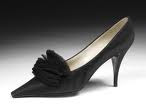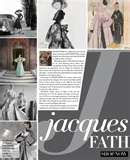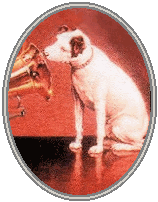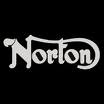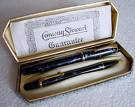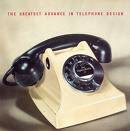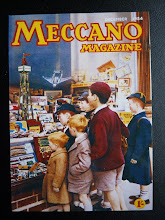" .... the bony corpse oscillated gently in the fierce
draughts of air funnelling through cracks in the abandoned
house."
From "1954: A Crime Novel" . Website: http://www.nickgarnettnovelist.com/
The first chapter of the book "1954" opens with a human skeleton tumbling out of a bricked-up chimney. The chapter closes with a girl's body slumped in the cleft of a rock on a creepy English moor.
From then on, the lonely figure of Detective Inspector Ray Stafford wrestles with a murder enquiry, while the privileged existence of textile mogul's wife, Jennifer Shaw, slowly succumbs to life's ugly underside.
The back drop of the 1950's, the era of Wolseley police cars and Dan Dare, is an intrinsic part of the book. For those who have not read "1954", this blog is a chat-through of how the novel treats the period. For those who have read the book's two hundred pages, here is a chance to look at other connected facts. If you want, add your comments about the book or deliver your thoughts about the 50's. Put your book reviews on Amazon. http://amzon.co.uk/
BRANDS
Ian Fleming was one of the first writers to pepper his prose with brand names. In the first seven pages of James Bond's earliest outing, Casino Royale, Jamaica's Daily Gleaner newspaper pops up, together with a .38 Colt Police Positive(Bond's first gun before the Beretta) and a Morris Minor. In "1954" Tommy Nelson buries his nose in Casino Royale during his flight to Karachi, and he is carted around that city in a Morris Minor.
Of the scores of brands featured in "1954", many have long vanished. Sadly, 'the disappeared' are often British - GEC for telephones, Pye for TVs, pens made by Conway Stewart and Osmiroid, cars from Alvis or Hillman. Many brands live on. Stephen Shaw's watch of choice is Omega (the brand used by Bond in the movies). Shaw owns a Cosmic and a Centenary, his wife a Sapphette. Omega, excellent in supplying details, has recently re-introduced some of the above watches in its high-price "museum" collection. Jennifer Shaw's perfume is Elizabeth Arden's Blue Grass, she drapes herself in Balenciaga, and the family kitchen is copied from a Poggenpohl. At least her husband's R-Type Bentley is of a still-alive British marque.
TELEVISION
Ray Stafford slumps in front of his tiny-screen, Yorkshire-made Fitton. Only one channel is available. Independent Television did not start broadcasting until nineteen fifty-five, but it was already boasting of the American shows it would be offering. Once ITV started up, it didn't take long for it to overtake, in viewer numbers, the stodgy British Broadcasting Corporation. (By the way, the BBC was pathetically and deliberately unhelpful in my research for "1954"). Startlingly, David Attenborough, who, at the age of 83, reached the North Pole in the spring of 2010, features in the TV programme Zoo Quest (chapter 18). In the year nineteen fifty-four, RCA of the US began the mass manufacture of televisions, and that year also saw the first televised football World Cup. It was won by West Germany.
CLOTHING
As an ex-model, Jennifer Shaw adores couture - Dior, Balenciaga, Harry Popper's clothes establishment in London. That's why it is such a shock to her when she reads about Jacques Fath (chapter 2). Her basic everyday clothing is supplied by Jaeger (a British label founded by a German), but Shaw has one eye on the comeback collection of Chanel. The French clothing house closed up during the Second World War and makes its comeback in the year of the book.
For the men, it's long raincoats, trilbys and homburgs. Not much evidence of any safety gear for demolition workers in chapter 1. The most unusual piece of attire in the novel "1954"? Percy Barraclough's face mask.
CARS
Jennifer Shaw drives a Mk Vll Jaguar saloon, similar to the motor once owned by the Queen Mother, though the latter's model was the faster 'M' version. The Mk Vll also happens to be the getaway car in the nineteen fifty-four film 'The Good Die Young' with Laurence Harvey and Joan Collins.
Shaw's second car is an Armstrong Siddeley Hurricane. The Siddeley was chosen because the marque's emblem is a sphinx, Shaw's modelling nickname. The Hurricane name derived from the World War ll aircraft made by the same company. (That plane, made out of wood and canvas, shot down more enemy aircraft than the Spitfire). I spoke to enthusiasts about the driving characteristics of the Hurricane car - thank you Keith Crampton - but I have still been subject to a bit of criticism about what I wrote in "1954".
Stephen Shaw rolls around in his R-Type. Bentley at Crewe thought that was a more typical vehicle for an industrialist to own than the vastly more expensive two-door Continental. I agreed. Ray Stafford's own mode of transport is a trusty Standard Vanguard beetle-back. I've included a bit of that company's history. He is surrounded, of course, by the ubiquitous police Wolseleys. The Riley Pathfinder is in the story because of its subsequent nickname, and the literary possibilities surrounding its gear lever. (That's got you guessing if you haven't read the book).
Plenty of other models dot the crime novel, such as Lionel Raistrick's Lanchester, the Alvis owned by the Mortimers, and Janet Tomlinson's drophead Hillman Minx. One of the car dealers in "1954" uses a Lea Francis shooting brake. Mercedes-Benz recently announced a concept estate car called a Shooting Break (nice play on words). The Merc in "1954" is not identified but would probably have been the 170 which is pictured in this blog. I think the enormous 300 Adenauer would have been stretching it. By the way, the post-war 300 model appears incorrectly in the 2010 film 'City of Life and Death' which was set in 1937. A lazy mistake by the Chinese film makers. One interesting fact about the year nineteen fifty-four - General Motors made its 50 millionth car.
Nice to include long-lost commercial vehicle marques - like the Guy Arab parked in the Yorkshire Dales (any chance of a model name like that now?), and the Leyland Lion receiving a spit and polish in Somerset.
The UK Petroleum Association was very helpful on petrol pricing, grades and brands. Who remembers Fina in Britain ?
MUSIC
In the year nineteen fifty-four, times they are a-changing. For one thing, Elvis Presley is starting his recording career, much to the bemusement of Mr. Reiniger (chapter 14). I do not give Reiniger a Christian name in "1954: A Crime Novel" though I imagine him as a 'Helmut'. For another thing, the Fender Stratocaster electric guitar hits the shops for the first time in this year.
Change though is a bit slow and a lot of the music remains welded in the sounds of the early Fifties. 'How Much is that Doggy in the Window', a nineteen fifty-three hit by Liverpool-born Lita Roza blasts out of a window somewhere, and 'Mambo Italiano' by George Clooney's aunt Rosemary is just what Ray Stafford does not want to hear in chapter 20. What music was everywhere in nineteen fifty-four ? 'Music While You Work', which bounces out of the radio in Bruce Chew's office at the Talbot hotel.
AVIATION
The Comet jetliner, a tragedy waiting to happen, plays a big part in "1954". A little piece of chapter 3 tries to capture the luxury of transatlantic flights. The Boeing 377 Stratocruiser, another plane cropping up in the novel, also appears in 'The Good Die Young'. (They really liked the prefix 'strato' in the nineteen fifties).
Silver City services from Lydd airport to Le Touquet, ferrying cars as well as passengers in converted Bristol Freighters, is one of the focal points of the book's last chapter. Another car-carrying passenger service operated from Southend using purpose-built Carvair aircraft. The Hollywood actor appearing in chapter 21 really did use a Silver City flight in nineteen fifty-four. I wonder if he was actually on the very plane featured in the novel?
The British Airways Museum at Heathrow deserves a big 'thank you' for the information it supplied on ticket costs, plane decor and flight schedules.
FOOD AND DRINK
Rationing came to an end in Britain in the summer of nineteen fifty-four. Characters in the novel are looking forward to binning their ration cards. Plenty of Spam in "1954", Rowntree's sweets and the Terry's chocolate apple. New cereal brands were making an impact and the teabag was starting to catch on(chapter 19).
Lots of dodgy food in dodgy cafes. Yet the precursors of all the biggest US fast-food chains - McDonald's, KFC and Burger King - were up and running in America by the year nineteen fifty-four, as Sinclair Ratledge discovers in chapter 14. Bettys in the same chapter was dishing out, in Harrogate and elsewhere, superior light cuisine. If "1954" has a food fulcrum, it is a bag of pig's cheek, turning up where it shouldn't.
As regards drinks, it is perhaps interesting to note that Scottish whisky was hardly ever offered as a single malt. Whisky, like the Grant's Stand Fast drunk by alcoholic doctor Gordon McCrone, almost always came blended. Chivas Regal makes a real comeback in nineteen fifty-four after a long absence from the market, and the barman at the Midland is well aware of that. Plenty of other drinks, defunct or still alive, make an appearance, from Tizer to Wm Younger's Edinburgh Ales.
MOTORBIKES
I am no motorbike enthusiast, but bikes are part of the plot. Scores of British manufacturers to chose from, so why not a Norton Dominator, AJS and Royal Enfield? (The Royal Enfield Bullett is still made in India where it is known as 'The Thumper'. That bike was first exported to India one year before the setting of the book). And what is it about the number 88? A Norton motorbike came with that derivation, as well as a Buick 'sports' saloon and an all-purpose German artillery gun. Edward Kennedy drove off a bridge at Chappaquiddick in an Oldsmobile Delmont 88. Any other 88s out there?
THE WRITTEN WORD
Newly-published comics came thick and fast in nineteen fifty-four. Newsagent Alfie Bairstow always seems to be struggling with them. In The Beano, issue 604, a new strip unfolds titled 'When The Bell Tolls', the forerunner of 'The Bash Street Kids'. Ray Stafford and Jennifer Shaw rely on the Daily Telegraph for news. Apart from 'Casino Royale', the newly-published 'Lucky Jim' and a collection of Somerset Maugham short stories are on the reading lists of the novel's characters.
GERMANS
It is not just Mr. Reiniger and goalkeeper Bert Trautmann. Germans make their presence felt everywhere in "1954", one way or another. Is there a book about Germany's cultural and industrial influence on Britain ? If not, there should be.
LOCATIONS
Somerset and Kent, Scarborough, Ilkley and the Yorkshire Dales all feature in "1954: A Crime Novel". But Bradford is at the book's heart.
So how does "1954" portray the Yorkshire city in that year ? Well, it was busy and very dirty. It had an almost all-white citizenship. The Jewish population was relatively small, but thriving and effective. A lot of stupendous Victorian architecture filled the town centre, though it was partly hidden under soot. Chunks of it, sadly, have been demolished. The quality of food in cafes was deeply suspect. Sweet and tobacconist shops were everywhere and forty picture houses showed movies. Consumer goods were usually British brands, made in Britain. People were, generally speaking, thin.
As Jennifer Shaw drives her white Jag into Bradford's city centre in chapter 2, she can hardly see anything out of the window, through the smog generated by the city's mill chimneys and its one hundred thousand coal-heated houses. The book uses pollution figures from the 1930s - 10,000 tons of carbon and ash and 60,000 gallons of tar cascaded down on the city every year.
German, mainly Jewish merchants built a whole district of often-ornate warehouses in the city in the late 19th century, before fleeing back home. Maurice Black, Shaw's solicitor, is a decendant of one of these merchants. His name is a nod to the real David Black, who was a GP and a Lord Mayor of the city.
South Asians form a tiny minority at this time. Tommy Nelson's trip to Karachi in chapters 7 and 13 is very much connected to the ethnic shift in Bradford's population over the following few decades. Nelson is looking forward to an evening of jazz at Karachi's Metropole Hotel. The hotel was a hub for Europeans. The blog contains the sad photo I took in 2009 of what is left of the Metropole.The Palace Hotel, also pictured, is where Nelson stayed during his visit in nineteen fifty-four.
"1954: A Crime Novel" features some of Bradford's buildings that were either torn down in later years, or which simply fell into disuse. In chapter 12, Detective Inspector Ray Stafford buys meat in Kirkgate market and carries out interviews in the Talbot commercial hotel. Both have long gone, though the name Talbot, carved into a stone lintel, is still visible today. Jennifer Shaw, in chapter 10, shops in Brown Muffs and in the Swan Arcade. One has long disappeared though its name remains on the building like a ghostly symbol.The other was demolished in the catastrophic redevelopment of the 1960s and '70s. The site of the colossal Exchange railway station is now the home of the main Law Courts, and the location of the Jowett car factory in Idle, where Henry Crabtree works in "1954", is now a shopping centre.
Some buildings featured in the novel still exist, though not quite as they were. The Midland and Gt. Northern hotels, for example, as well as the former Bradford Commercial Bank with its brilliant ceiling, the City Hall, and the striking cemetery at Undercliffe. Stephen Shaw's somewhat fantastical wool mill is a fictitious creation. I wonder what would have happened to it?
Away from Bradford, the small village of North Curry, near Taunton, provides the backdrop for part of chapter 16. It was a thriving business hub then, and I've tried to capture accurately the range of commercial enterprises there in nineteen fifty-four. Real hotels in Folkestone and Scarborough are described, and the locally-famous Ribblehead Viaduct in the Yorkshire Dales is a looming presence. Ilkley, the location of the Shaw's magnificent house and the place where Moira Nelson's body is found, continually features throughout "1954: A Crime Novel".
TOYS AND HOBBIES:
Toys were a big part of life for children in the 1950's, just as they are now. Types and brands were, of course, somewhat different. They pop up from time to time in the book, and a real toyshop, Carter's, is a centre-point of one chapter. Dinky Toys made die-cast models, but Corgi did not come on stream until 1956. Hornby made model trains, as it does now, but in the 1950's, so did Tri-Ang, which moved to a new factory in Margate in 1954. Airfix produced some plastic models, but its first aircraft kits were not sold until 1955. Meccano was a big supplier of metal construction kits, the Lego of its time. A lot of children simply made do with 'Red Indian' head dresses, cowboy outfits and plastic six-shooters, as well as home-made wooden go-carts. These were known in the area in which "1954" is largely set as 'guiders'.
HISTORY:
Information about current affairs in the year 1954 are sprinkled throughout the book, mainly through newspaper coverage of the time. This was a period when colonial empires were on the backfoot. Dien Bien Phu, the defeat that saw the collapse of French rule in Indochina, gets a write-up in "1954". I have recently been to this Vietnam town, so here is my own photo of the commemorative pillar in the town's military museum. The year ninety fifty-four lives on in all sorts of ways. Dick Barton - Special Agent, as featured in chapter 16, is being resurrected. More than 300 lost radio episodes were discovered in 2011 in Australia. If you have been interested in reading about the "revolution" in Egypt you might have noticed that it was 1954 when the Muslim Brotherhood was banned. Read about the way 1954 is still with us on the book's website www.nickgarnettnovelist.com.
HUMAN BEHAVIOUR:
Perhaps people do not change much, one generation to another. Yet there are certainly shifts in behaviour. One example in "1954", with a modern comparison, is the tiny child in chapter 11. The kid pedals its tricycle on its own along the pavement and almost out of view, of little concern to the police officers watching the child. Contrast that with the recent kerfuffle over the family in south London who have been warned by the Authorities about allowing their children to cycle to school without supervision.
NAMES:
Some of the most famous people born in the old West Riding of Yorkshire have given their names to characters and streets in "1954". Can you spot them ? And who is the art student in chapter 10 ?
Tuesday, February 15, 2011
Subscribe to:
Comments (Atom)






